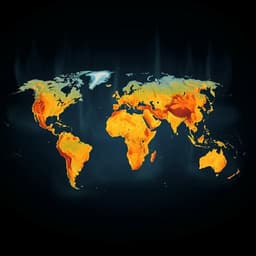
Environmental Studies and Forestry
Global forest fragmentation change from 2000 to 2020
J. Ma, J. Li, et al.
Explore the fascinating trajectory of forest fragmentation globally from 2000 to 2020, revealing unexpected trends and urgent calls for action. This compelling research conducted by Jun Ma, Jiawei Li, Wanben Wu, and Jiajia Liu emphasizes the critical need for enhanced connectivity among forest fragments, especially in tropical regions, to combat deforestation effectively.
Playback language: English
Introduction
Forest fragmentation, a significant driver of biodiversity loss and ecosystem degradation, has been inconsistently quantified globally. Previous studies have yielded conflicting results regarding the relative fragmentation levels of tropical versus temperate forests. Some studies suggest tropical forests are more contiguous, while others indicate they are experiencing the most severe fragmentation due to accelerated deforestation. These discrepancies might stem from variations in the definition and temporal scales used to assess fragmentation. A comprehensive, dynamically-focused quantification of global forest fragmentation is crucial for guiding effective forest conservation and restoration policies. Forest fragmentation is a dynamic landscape-level process characterized by changes in patch size, number, and edge density. Accurate assessments are critical for understanding its impacts on biodiversity and ecosystem services. Previous studies, however, have largely relied on static landscape patterns, overlooking the dynamic nature of fragmentation over time. The long-lasting effects of fragmentation necessitate accurate quantification of current patterns and dynamics to prevent further biodiversity loss and ecosystem degradation. The dynamic interplay of deforestation and afforestation further complicates fragmentation assessment. While fragmentation is often linked to forest loss, these processes are not always directly correlated. Many temperate and subtropical regions have experienced forest cover gains, yet these gains do not necessarily reverse fragmentation trends. Therefore, integrating changes in forest cover and fragmentation patterns is crucial for informed forest management.
Literature Review
Existing literature on global forest fragmentation presents inconsistent findings regarding the relative fragmentation levels of tropical versus temperate forests. Some research suggests tropical forests are more contiguous than temperate forests, while others point to the tropics as experiencing the most severe fragmentation due to the acceleration in deforestation rates in these regions. These contrasting results may be attributed to variations in the definition and temporal scales used to assess forest fragmentation. The impact of forest fragmentation can persist for decades, even centuries, highlighting the need for a comprehensive and dynamic assessment of the current state and trends of global forest fragmentation.
Methodology
This study employed a novel synthetic Forest Fragmentation Index (FFI) to capture the main characteristics of forest fragmentation, including edge, isolation, and patch size effects. Using high-resolution (30 m) global forest cover data for 2000 and 2020 from the global land cover and land use (GLCLU) change datasets, the researchers calculated static FFIs for both years and a dynamic FFI (AFFI) representing the change between 2000 and 2020. The analysis utilized a 5000 m grid to calculate FFIs and forest coverage (FC). The three components of the FFI – edge density (ED), patch density (PD), and mean patch area (MPA) – were normalized to ensure comparability across different regions and years. The AFFI (ΔFFI = FFI2020 – FFI2000) indicated the direction and magnitude of fragmentation changes. The study compared static and dynamic FFIs across various climatic zones (tropical, subtropical, temperate, and boreal) and altitudinal categories. Statistical analyses, including ANOVA, LSD tests, generalized additive models (GAMs), and linear correlations, were employed to assess differences and relationships between variables. Eight modes of fragmentation processes were identified based on the combinations of changes in ED, PD, and MPA. To analyze the drivers of fragmentation changes, the researchers selected six hotspots (three with decreased FFI and three with increased FFI) and examined the relationships between AFFI and explanatory factors such as anthropogenic activity (nighttime light, cropland coverage), demographic pressure (population density), and natural disturbance (fire frequency) using generalized linear models. A two-dimensional framework was developed to comprehensively assess forest landscape dynamics based on changes in both FC and FFI, categorizing forest landscapes into four patterns: increased coverage and decreased fragmentation (FC↑FFI↓), increased coverage and increased fragmentation (FC↑FFI↑), decreased coverage and decreased fragmentation (FC↓FFI↓), and decreased coverage and increased fragmentation (FC↓FFI↑). This framework was applied to analyze forest landscape dynamics at global and national scales.
Key Findings
The study revealed that while tropical forests remained relatively intact in 2000, they experienced the most significant increase in fragmentation between 2000 and 2020. In contrast, 75.1% of the world's forests showed a decrease in fragmentation, primarily in temperate and subtropical regions of northern Eurasia and South China. The static FFI (FFI) indicated that the most fragmented forests were located in subtropical regions, while the most intact forests were found in tropical and boreal regions. The dynamic FFI (AFFI) showed a markedly different pattern, with most regions exhibiting decreased fragmentation, whereas tropical regions showed a significant increase. The analysis of eight fragmentation modes revealed that in areas with decreased FFI, the most prevalent mode was characterized by decreased edge density (ED), decreased patch density (PD), and increased mean patch area (MPA). Conversely, in areas with increased FFI, the most common mode displayed increased ED, increased PD, and decreased MPA. Hotspot analysis identified different driving factors for fragmentation changes in different regions. For instance, wildfire frequency was the most significant factor in western Canada, while cropland coverage and change were more influential in southern Europe and central China. In hotspots with increased FFI, wildfire frequency was the dominant driver in the southeastern Amazon and central Siberia. The two-dimensional framework categorized forest landscapes into four dynamic patterns based on changes in FC and FFI. The FC↑FFI↓ pattern (increased coverage, decreased fragmentation) was widespread, particularly in temperate and boreal regions. The FC↓FFI↑ pattern (decreased coverage, increased fragmentation) was most pronounced in tropical regions. National-scale analysis revealed a significant negative correlation between AFFI and AFC, suggesting that efforts to increase forest cover were effective in mitigating fragmentation. Among the ten countries with the largest forest areas, the FC↑FFI↓ pattern was dominant in Russia, Canada, the US, and China, while the FC↓FFI↑ pattern predominated in Brazil, the Democratic Republic of Congo, and Peru.
Discussion
The findings of this study highlight the complex and regionally diverse patterns of forest fragmentation, emphasizing the need to move beyond static assessments to understand dynamic changes. The contrasting trends between tropical and temperate/subtropical regions underscore the critical need for targeted conservation efforts, particularly in the tropics, where deforestation and fragmentation continue to pose significant threats. The development and application of the synthetic FFI and the two-dimensional framework provide a more nuanced and comprehensive approach to evaluating forest landscape dynamics. The identification of key drivers of fragmentation (wildfires, agricultural expansion) in different regions allows for more effective policy interventions. The negative correlation between AFFI and AFC at the national level underscores the importance of afforestation and reforestation programs in mitigating fragmentation, even in the presence of ongoing deforestation. Future research should focus on integrating finer-scale data, considering specific species and vegetation types, and incorporating multi-temporal data to improve the accuracy and detail of fragmentation assessments. Understanding the interplay between climate change, land use policies, and international trade is also critical for effective management and conservation.
Conclusion
This study provides a comprehensive assessment of global forest fragmentation dynamics between 2000 and 2020 using a novel synthetic FFI and a two-dimensional framework. The findings highlight the divergent trends between tropical and temperate/subtropical regions and the importance of considering both forest cover changes and fragmentation patterns. The results emphasize the urgent need for targeted conservation and restoration efforts, particularly in tropical regions, to mitigate biodiversity loss and maintain ecosystem services. Future research should focus on refining methodologies, incorporating finer-scale data, and investigating the complex interactions between various drivers of forest fragmentation.
Limitations
The study's reliance on bi-temporal forest cover data may limit the ability to fully capture the continuous dynamics of forest fragmentation, particularly in regions with complex land-use changes. The use of aggregated data at a 5000 m resolution might obscure finer-scale fragmentation patterns. Further research with higher-resolution data and more frequent monitoring could enhance the accuracy of fragmentation assessments. The analysis of drivers focused on a limited set of variables; a more comprehensive investigation that integrates additional factors could offer a more complete understanding of fragmentation dynamics.
Related Publications
Explore these studies to deepen your understanding of the subject.







